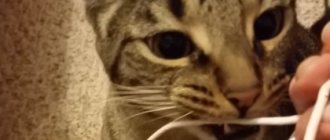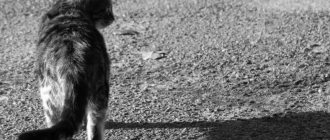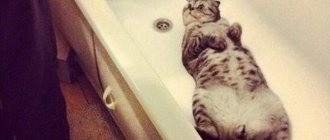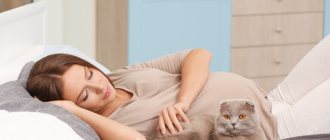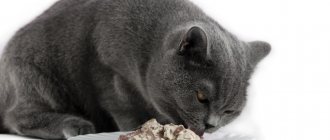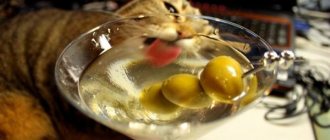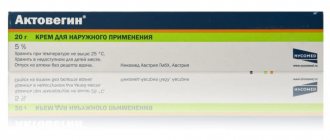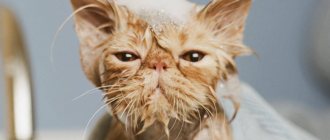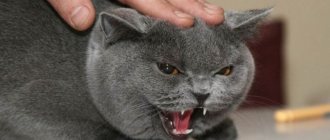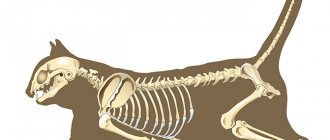Owners of domestic cats often notice that their furry pets from time to time lie on their backs and roll around on the floor. Most often, cat owners associate this with playing or pampering the animal, but not everyone knows that in fact there can be several different reasons. So, why cats can roll on the floor, we will tell you in our article.
Communication style
For all animals, behavioral reactions and display of postures are an effective way of communicating with relatives and warning signs for ill-wishers. Representatives of the cat family are very graceful and anatomical, which, combined with a highly developed psyche, makes their body language as informative as speech for humans.
The basic Instinct
Under the influence of sex hormones, a cat’s behavior changes dramatically, triggering a chain of complex psychophysiological reactions associated with finding a partner, mating, bearing offspring, giving birth and caring for babies:
- Sexual hunting . The period of sexual activity in females is called “estrus” (translated from Greek as “passion, frenzy”), and in the cat family it is expressed unusually brightly and intensely. Wild cats, usually leading a solitary lifestyle, demonstrate their readiness to mate very clearly, literally seducing the male. In a pride, a lion secludes himself with a lioness in heat and mates with her every 20-30 minutes. Domestic cats repeat the ritual of their wild ancestors in mating games, sometimes “walking” so violently and loudly that they haunt the whole family for several days. An inviting loud meow, arching of the back in an eloquent stance on half-bent legs with a raised tail are replaced by turning over on the back and uterine purring. This is how a cat calls a cat. Cats can lie belly up and roll on the floor from excess feelings immediately after mating. Cattery owners know that such behavior is one of the clear signs of a successful cat “wedding,” which can take place far from human eyes.
- "Interesting situation" . A pregnant cat may roll on its back, making vibrating sounds in its throat. Even when signs of pregnancy are still invisible to the owner, altered hormonal levels dictate different behavior patterns for the animal. First-born cats who do not yet have experience in bearing offspring are especially prone to “gymnastics for pregnant women.” The expectant mother feels the birth of a new life inside her and is undoubtedly excited. In the second half of pregnancy, when the kittens are already actively moving and stretching their legs, she can growl at the naughty kids in her stomach, growl loudly or lick them through her side.
- Mother-nurse . The mother cat lies on her back to provide her newborn kittens with access to her nipples. If the birth went well and the whole family is happy, the nurse sleeps blissfully, warming the precious babies.
Rolling on the floor as an expression of playfulness
Of particular note is the tendency of cats to roll around near their owner’s feet. As a rule, this happens when the owner is busy with some business. In this case, the cat wants to attract his attention and hints that the owner should drop everything and pet her or play with her. In other words, this is a manifestation of playfulness and desire for contact. When the owner is constantly busy with something, and the cat is forced to spend all the time alone, she is sometimes forced to deliberately attract the attention of her owner. In this case, you should really take a break from your affairs and devote at least a minute or two to your pet. However, you should warn in advance that cats are crafty creatures and, exposing its belly to the owner and inviting the owner to pat it, the cat will immediately grab his hand with its claws.
Demonstration of trust
A satisfied and calm cat in its territory playfully rolls from side to side, gracefully stretches out and squints its eyes. At the same time, her muzzle radiates bliss and serenity - this is how an animal invites a familiar person to careful caresses and gentle stroking.
A sign of friendship and goodwill towards a person or fellow tribesman for a cat lying on its back is the stretching of its front paws with soft pads.
Dust as a means of camouflage
Cats living in the wild are forced to provide their own food, and their prey also has some intelligence. But besides this, she also has a fairly developed sense of smell, thanks to which she can sense the presence or approach of a hunter. To get rid of this, on the one hand, the cat constantly licks itself to minimize its natural aromas, and on the other hand, it tries to mask them by rolling out in the dust. Even if the smell of a cat seeps through the smell of dust, it will be little distinguishable from the smell of ordinary cat tracks left on a dusty path, which can dull the vigilance of potential prey, which cats successfully use. And although in urban environments there is no need for camouflage, the habit turns out to be second nature not only for humans, and cats continue to wallow in the dust, as if they were still living somewhere in arid Africa and tracking down local small rodents.
Click “Like” and receive only the best posts on Facebook ↓
Why does a cat suddenly take a strange position, lying belly up, turning from side to side and rolling on its back? Perhaps this is a sign of anxiety, euphoria or illness? It can be difficult for an inexperienced owner to understand the reason for the behavior and coloring of the mood of a pet “who walks on its own,” given its independent and freedom-loving nature. And here the observations of felinologists, ethology specialists, zoopsychologists, naturalists and biochemists come to the rescue, allowing us to decipher animal signals and desires.
Dormant Predator
Even when in a relaxed position with their eyes closed, cats sense a violation of the boundaries of their personal space and the intentions of the person approaching. And only a slight twitch of the tip of the tail reveals inner sensitivity and sharpness of instincts.
If the object does not pose a threat, the animal remains in place, but in the event of a sudden movement or shout, the cat instantly turns over, hiding its tender tummy and preparing to run or fight. You should never give in to emotions when trying to scratch the tummy of an unfamiliar sleeping cat: in this case, the troublemaker will receive a hard blow with a paw with its claws extended.
Scent marks
Sometimes cats ride on their backs, marking territory or things with their personal scent. At the same time, they grumble, “trample” their paws, releasing their claws, and rub their cheeks, on which special secretory glands are located.
A cat can similarly “appropriate” a person or mark his things, for example, by lying belly up in a laundry basket.
This is how the mustachioed striped animals try to drown out foreign odors that were collected outside the house and remained on the skin and fabric.
Cat playing in the greenhouse
The greenhouse is an important structure on the site; it is difficult for a cat to pass by it when it is open - you should definitely look. In cool weather, you can lie in it on hay mulch among tomato and cucumber bushes and sleep for several hours until you want to eat. This is what Musya mostly does here.
What is Barsik doing?
In the middle of summer, when warm weather sets in, it becomes unbearably hot inside the greenhouse and it is simply impossible to stay in it for a long time in a thick cat fur coat. In this situation, the door to this room usually remains open during the day. The red-haired prankster found amusement in this too - he pushes away the door that opens with the wind with his feet (as if springing).
All this happens against the backdrop of active rubbing of dust accumulating on the clay bricks of the garden path into the wool. The cat is actively rolling on its back, apparently trying to be properly covered in mud from all sides. And then he returns to the house, jumps on the snow-white tablecloths, bed linen, walks around the tables, sniffing the plates.
Euphoria from aromas
Some smells cause a state of euphoria in cats. As soon as the molecules of the coveted aromas reach the mucous membrane of the olfactory tract, the mustachioed striped animals begin to run from corner to corner, roll on the floor, purr loudly and rub their skin against the scent mark.
The stimulating effect usually lasts 15-30 minutes, after which the animal calms down and falls into deep sleep.
From the plant world, two species are most attractive to cats:
- Alcohol infusion of valerian or its tablet form . Widely used as a cardiac and sedative in medical pharmacology. However, valerian has a stimulating effect on cats because it contains organic acids that resemble the smell of pheromones. The attractive smell causes the cat to lick the medicine or chew the stems of the plant, which is why valerian is called the “cat drug”. At the same time, the effect on the hormonal system and psyche is so strong that some animals go on a rampage, receiving a psychotropic effect with hallucinations, drooling and convulsions. Trying to get to the coveted drug, they can turn over or break a bottle of alcohol solution and get a burn to the mucous membrane and severe poisoning. After a prolonged attack, inappropriate behavior can persist for several days, manifested by increased excitability, fear of loud sounds, apathy and refusal to eat and drink. It is noteworthy that about 70% of the population of mature cats are sensitive to valerian, while in females this figure is halved. The intoxicating effect does not apply to kittens.
- Catnip, or catnip . It is completely harmless to cats and is even sold in pet stores in the form of sachets or powder. If your favorite ball or toy mouse is sprinkled with catnip, the cat will play for at least a quarter of an hour, after which the happy cat will fall asleep next to it. Felinologists recommend using the properties of the plant as a natural antidepressant by placing a sachet with catnip in a carrier cage with a cat when moving or to a new place.
Why do cats lie on their backs?
The reasons why a cat lies on its back may be due to its childhood. From birth, a small kitten gets used to the fact that the mother cat licks him with her tongue, massaging her tummy especially carefully. This is a kind of hygienic procedure and at the same time a measure to prevent the occurrence of ailments of the digestive system.
After such a massage, the kitten feels great, he is calm, he can immediately fall asleep or play vigorously, choosing the tail of his mother cat as a toy.
A grown pet retains this pleasant part of its childhood in its memory and sleeping on its back gives it a feeling of complete calm. Often, kittens climb into a person’s bed, lie down and fall asleep with their paws up. In this way they try to find their mother and protection on a subconscious level.
If a cat lies on its back in its usual conditions, not far from a person, then this indicates the pet’s normal well-being, complete trust in the environment and its owner. This indicates a warm relationship between a cat and a person and that the pet loves its owner very much.
An indicator of the highest degree of trust is when the cat lays down on the floor and turns over on its back with its paws up, doing “stretches”. The pet’s trust still needs to be earned.
What does lying on your back mean?
:
- This means that the cat is comfortable with humans.
- Confidence. For most cats, the stomach is a very vulnerable place, and if a pet opens it, this indicates the highest degree of trust in the owner.
- The onset of puberty or sexual desire. An uncastrated animal often feels slight discomfort in the groin during this period, and sleeping on its back with its paws outstretched helps to get rid of the discomfort.
- Bliss. A sweet nap on the back indicates that the cat is completely satisfied with life.
- The pet is simply hot. This position serves as a way to cool the cat’s body.
Skin problems
Unbearable itching and irritation of the skin in the back area can cause a cat to roll irritably on the floor. This may be caused by flea dermatitis, pruritic scabies or skin allergies. It is the owners' duty to carefully examine the animal and, if they find redness, dandruff, bald patches or weeping areas on the skin, immediately contact a veterinarian.

